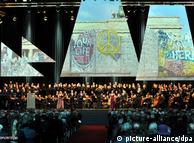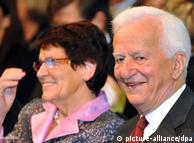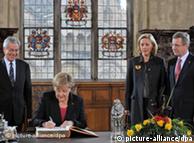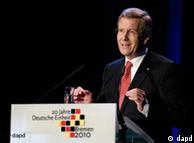德国纪事 | 2010.10.03
纪念统一20周年 总统呼吁全民团结
活动以宗教典礼开始
 Bildunterschrift: 庆典现场10月3日上午,正式庆祝活动在不来梅圣彼德大教堂举行,以宗教典礼开始。德国总统伍尔夫、总理默克尔和联邦部长、州长、各国大使和公民代表团参加了典礼。
Bildunterschrift: 庆典现场10月3日上午,正式庆祝活动在不来梅圣彼德大教堂举行,以宗教典礼开始。德国总统伍尔夫、总理默克尔和联邦部长、州长、各国大使和公民代表团参加了典礼。天主教主教博德(Franz-Josef Bode)在他的祷词里指出20年前的和平转折带来的成就,他呼吁在场人士珍惜来之不易的统一,"在当前社会、教会和世界所处的危机时期,我们应该把对一 个统一的、强大的德国的感激和喜悦之情理解成挑战,要作出一切努力,继续从真实的、深刻的转折里汲取动力。"这位主教在他的祷词里却也没有放弃批评性的言 论,他指出在转折之后一度出现过肆无忌惮的行为。
基督新教的批评
代表不来梅基督新教,神父勃拉姆斯(Renke Brahms)对这个社会日益扩大的社会分裂提出批评。他说,现在的界限不再是划在东西部之间,而是,"今天的大墙隔在了穷人和富人之间,同样也隔在北方和南方之间,隔在各地区和城区之间。"
针对经济危机,他说:"如果谁的目光不是放在大众所急需的、公平发放的金钱上,而是放在自己的红利上,谁就不单是一个自私自利的人,他同时也危害着统一。"他指出,增长不仅仅体现在经济和金融上,而也体现在不同思维方法、不同文化和宗教的人相互间的关系上。
伍尔夫向统一的斗士们致敬
 Bildunterschrift: 那时的德国总统魏茨泽克和联邦议院议长许斯穆特联邦总统伍尔夫首先赞扬了20年前推倒柏林墙的东德人的勇气,"我向所有为统一斗争过的人鞠躬。"在近100天前的总统就职演说里,他曾经强调指出,东德人的转折意愿至今没有得到足够的报答。
Bildunterschrift: 那时的德国总统魏茨泽克和联邦议院议长许斯穆特联邦总统伍尔夫首先赞扬了20年前推倒柏林墙的东德人的勇气,"我向所有为统一斗争过的人鞠躬。"在近100天前的总统就职演说里,他曾经强调指出,东德人的转折意愿至今没有得到足够的报答。在来自德国各地和世界各国的贵宾面前,伍尔夫警告大家高度警惕老人与年轻人、高收入者与低收入者、民众与民众代表、以及文化与宗教信仰不同的人之间 的鸿沟变大。伍尔夫没有直接提到前联邦银行董事扎拉青的名字,不过指出,这场辩论是必要的,但不能允许这样的辩论伤及有外国背景的公民。
尊重和捍卫宪法
伍尔夫明确提出,"我们是一个民族"这一统一时的口号应该成为对所有人的邀请。所有生活在德国的人都必须尊重与捍卫宪法及其规定的价值。他说:"谁不这样做,谁渺视我们的国家和它的价值,谁就会遭遇坚决的反击,无论对原教旨主义者,对右的或左的极端主义者来说都是如此。"
总统也指出问题的所在:在许多领域里,比如在给全家人开设的融合班和语言班,在用母语开设的课程,或者在由在德国学成的老师兴办的伊斯兰宗教课方面,都还有需要改进的地方。任何孩子都不应该在没有德语知识的情况下入学,也不应该在没有完成学业的情况下离开学校。
呼吁宽容与团结
伍尔夫总统同时要求在整个社会里出现更多的宽容,妥协能力和团结精神,他呼吁高层人士:"谁属于社会菁英,属于责任层和决策层,如果他走入一个分隔开的世界,他也就脱离了这个社会。"
 Bildunterschrift: Großansicht des Bildes mit der Bildunterschrift: 默克尔在不来梅市政厅留言,站着的是伍尔夫夫妇和不来梅市长博伦森伍尔夫呼吁德国人,与其他人共同去完成未来的任务,"最卓有成效的加强凝聚力的方法,是信任别人,放手让他们去做些事情。"他说:"要让这个国家成为一个家,大家的家。"
Bildunterschrift: Großansicht des Bildes mit der Bildunterschrift: 默克尔在不来梅市政厅留言,站着的是伍尔夫夫妇和不来梅市长博伦森伍尔夫呼吁德国人,与其他人共同去完成未来的任务,"最卓有成效的加强凝聚力的方法,是信任别人,放手让他们去做些事情。"他说:"要让这个国家成为一个家,大家的家。"祝福与庆祝
祝福与祝愿从世界各地飞来。美国总统奥巴马在白宫发表的一个声明里说,德国是美国最紧密的盟友和最好的朋友之一,美国人对他们为保卫自由的柏林和支 持德国人走向人的尊严方面起到的作用感到自豪。俄罗斯总统梅德韦杰夫在贺电里强调了俄罗斯对德国和欧洲统一起到的"关键作用"。
在不来梅,大型民众庆祝活动周六已经开始,周日继续着。在柏林的勃兰登堡大门那里设立了一个大型庆祝场。周日晚上,联邦议院将自己举办一个活动来纪 念20年前的大庆典。晚上,还将在柏林宪兵广场的柏林音乐厅举行统一奖"Quadriga"颁奖仪式,大奖将颁给联邦国防军、希腊总理帕潘德里奥、最后一 任德意志民主共和国总理德梅齐尔(Lothar de Maiziere)和现任联邦财政部长朔伊布勒。朔伊布勒在20年前参加了统一条约的讨论。
作者:Eloeonore Uhlich 编译:平心
责编:苗子
City (pop., 2002 est.: city, 540,950; metro. area, 849,800), northwestern Germany. Located on the Weser River, it was established as a diocese in 787 by Charlemagne and was the seat of an archbishopric from 845. In the 10th century it became an economic centre of northern Germany, especially after entering the Hanseatic League in 1358. It joined the German Confederation in 1815 and the reconstituted German Empire in 1871. It suffered extensive damage in World War II; after the war Bremen, with nearby Bremerhaven (pop., 2002 est.: 195,863), became a state of West Germany. Today the state, covering 156 sq mi (404 sq km), forms an integral part of the German economy and serves as headquarters for many industries.
-----
Bremen (brā'mən), city (1994 pop. 551,600), capital of the state of Bremen, NW Germany, on the Weser River. Known as the Free Hanse City of Bremen (Ger. Freie Hansestadt Bremen), it is Germany's largest port after Hamburg and is a commercial and industrial center trading in cotton, wool, tobacco, and copper. The city's products include ships, aircraft, steel, machinery, electrical equipment, textiles, beer, and foodstuffs, particularly roasted coffee. In recent years Bremen has employed about half its workforce in commerce, transportation, and the service sector. The shipyard that was once its largest employer closed in 1996. Bremen is Germany's oldest port city. It was made an archbishopric in 845, and under Archbishop Adalbert (1043-72) it included all of Scandinavia, Iceland, and Greenland. The archbishops held temporal sway over a large area between the Weser and Elbe rivers, but the city of Bremen itself remained virtually independent as its importance grew. In 1358 it became one of the leading members of the Hanseatic League. It accepted the Reformation in 1522, and in 1646 it was made a free imperial city. It stubbornly fought to preserve this status after the archbishopric had been assigned to Sweden by the Peace of Westphalia and later was ceded (1719) by Sweden to the elector of Hanover (George I of England). Bremen was occupied by France from 1810 to 1813. The city's overseas trade-from the late 18th cent. particularly with the United States-grew in the 19th cent., partly because of the founding (1827) of nearby Bremerhaven and the establishment (1857) of Norddeutscher Lloyd (North German Lloyd), a large shipping company. The city joined the German Empire in 1871. After World War I, there was a short-lived (1918-19) socialist republic of Bremen. The city was badly damaged by bombs during World War II, but numerous historic monuments remain, including the Gothic city hall (1405-9); the statue of Roland, the medieval hero, which was erected in 1404 as a symbol of the city's freedom; the cathedral (begun 1043), a blend of Romanesque and Gothic styles; and two noted churches-the Liebfrauenkirche (13th cent.) and the Johanneskirche (14th cent.). The city has a major art museum and a museum of overseas ethnology. The state of Bremen (1994 pop. 674,300), 156 sq mi (404 sq km), was formed in 1947 by combining Bremen and Bremerhaven.

沒有留言:
張貼留言